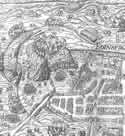Edinburgh Castle HistoryThe Lang SiegeIn 1571, following years of civil rivalry, the castle was held by supporters of Queen Mary (Secretary Grange), against the rule of new regent the Earl of Lennox (who supported the then infant King James VI). The resulting siege of the castle would last for two years and become known thru history as 'The Lang Sienge'. In May 1571 the episode began with a month long siege on the town it'self, followed by another in October. During this time the Earl appealed for offensive military assistance from Elizabeth I while Grange fortified the castle and sought help from France. Elizabeth agreed only to send ambassadors who successfully negotiated a truce in July 1572. This resulted in Grange being confined to the castle, and the town being surrendered to the Earl. On January 1 1573 the truce expired and Grange began bombarding the town of Edinburgh from the castle. He had 40 cannon at his disposal but only 9 gunners with little powder and shot. The King's forces now headed by a new regent - the Earl of Morton, prepared a siege. They entrenched themselves around the castle and poisoned St Margarets Well. By February that year Grange was running low on water inside the castle but was still firing upon the town. A number of Edinburgh residents were killed and Grange became unpopular among the townsfolk. This was inflamed when Grange sent his men into the town for supplies, burning 100 homes and killing more civilians in the process. In april, Sir William Drury led 1000 English troops into Edinburgh assisted by 27 cannon from Berwick-Upon-Tweed. A battery was installed on Castle Hill to attack the East wall, along with a further five batteries to the North, South and West. The first shots were fired on May 17 and by the 23rd the castle has been sent almost 3000 shots and David's tower as well as the Constables tower was destroyed. The debris from both towers blocked the castle entrance and isolated the outer castle fortifications, which were captured by the English on May 26. Grange called a ceasefire while his surrender was negotiated, he attempted to stall proceedings but his own men threatened mutiny and he surrendered to the English on May 28. The garrison were allowed to go free, but Grange and his brother, along with two jewellers who had been minting coins within the castle in Queen Mary's name were hanged at The Mercat Cross on August 3 1573.
Written by Shaun Flanagan |
|
|||||
